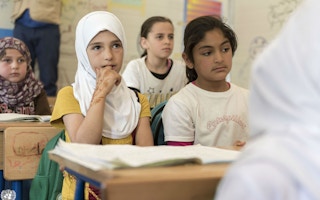When I visited the Zaatari refugee camp in Jordan earlier this year, I met with children who told me what education means to them. For Syrian youths who have been forced from their homes and have lost everything, education is about more than qualifications or test scores; it embodies their hope for the future.
To continue reading, subscribe to Eco‑Business.
There's something for everyone. We offer a range of subscription plans.
- Access our stories and receive our Insights Weekly newsletter with the free EB Member plan.
- Unlock unlimited access to our content and archive with EB Circle.
- Publish your content with EB Premium.
Children like those in Zaatari, and millions of others around the world, are central to the work of the International Commission on Financing Global Education Opportunity, which I joined last September. This commission is committed to the fourth United Nations Sustainable Development Goal, which aims, by 2030, to “ensure inclusive and equitable quality education and promote lifelong learning opportunities for all.”
This goal is still a distant prospect for far too many children. With so many development issues demanding our attention, policymakers should bear in mind that education is not just a good in itself; it is also a catalyst for many other development gains.
As the old African proverb goes, if you educate a girl, you educate an entire nation. Ensuring access to quality education for children, especially girls, will lead to fewer child marriages and less child labor and exploitation.
And education has long-term societal benefits: aside from increased political engagement, educated children contribute intellectual capital and pursue entrepreneurial opportunities when they grow up, boosting economic growth.
Tackling the education challenge needs to start from two principles embedded in the goal.
First, “for all” means that we must focus on the children who have been left behind. Millions of children are out of school or are receiving a substandard education because of who they are or where they live. According to the UN High Commissioner for Refugees, refugee children are five times more likely to be out of school than other children in the countries to which they’ve been displaced.
And in all but two African countries, girls remain less likely than boys to complete a primary education. Getting these children into school will require new approaches that directly address their exclusion and make schooling genuinely accessible and relevant.
Second, “quality”: Education must be effective, so that children actually learn. For the 61 million children who are out of primary school, formal education is beyond reach. But, just as urgently, more than one-third of children of primary-school age – 250 million – are not learning the basics, according to the UNESCO Education for All Global Monitoring Report.
Half of these children have been in school for at least four years. We must address the barriers to learning, both in the classroom and at home, by improving the quality of teaching and classroom conditions and teaching parents how they can support their children’s education.
Upholding these two principles will require increased investment. Last year, UNESCO calculated that governments must double education spending as a share of national income to achieve the 2030 goals. This will require increased revenue from taxation and stronger efforts to collect what’s owed. Donors also need to live up to their aid commitments and target aid more effectively.
For example, less than one-third of education aid goes to Africa, even though the region accounts for almost two-thirds of out-of-school children. Moreover, at the moment, education budgets are often regressive, with almost half of spending in the poorest countries allocated to the most educated 10 per cent of the population.
“
With so many development issues demanding our attention, policymakers should bear in mind that education is not just a good in itself; it is also a catalyst for many other development gains.
Fixing education investment requires action in two key areas.
First, we need equitable financing, with more investment in early childhood care and development, where there is the biggest potential for returns. Budgets must be focused on the most excluded children, and primary education must be free at the point of use, so that every child can learn. We also urgently need more transparency and accountability, so that budgets are visible and communities have a say in school governance.
Second, we need to strengthen domestic education systems so that governments see themselves as the guarantor of accessible, quality schools for their citizens, rather than abdicating that role to outside development agencies.
In particular, we should push for partnerships between government and business to boost domestic resources for education, and eliminate illicit capital flows that deprive governments of the means to fund it, such as tax evasion and money laundering across national borders.
With these priorities in mind, the education commission will deliver its recommendations at the UN General Assembly on September 18, when the Secretary-General will receive and act on them. The education commission will have succeeded if we are able to leverage the funding and political will to ensure that every child learns, regardless of their income, location, or social status. Our work will not be complete until that happens.
Helle Thorning-Schmidt, former Prime Minister of Denmark, is the Chief Executive of Save the Children and a Commissioner on the International Commission on Financing Global Education Opportunity.
Copyright: Project Syndicate, 2016.
www.project-syndicate.org









